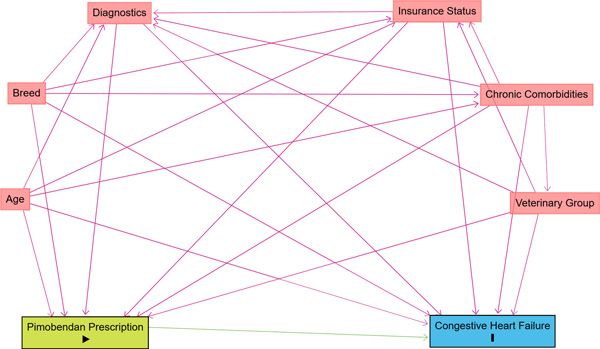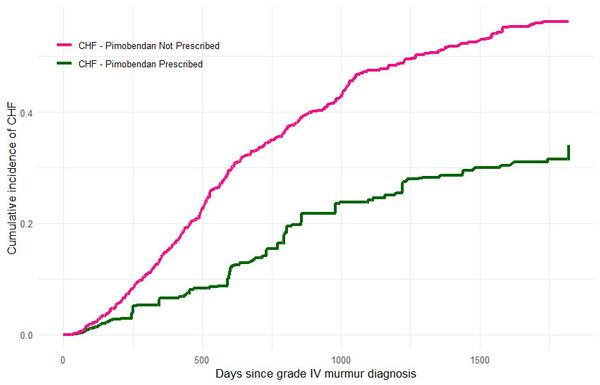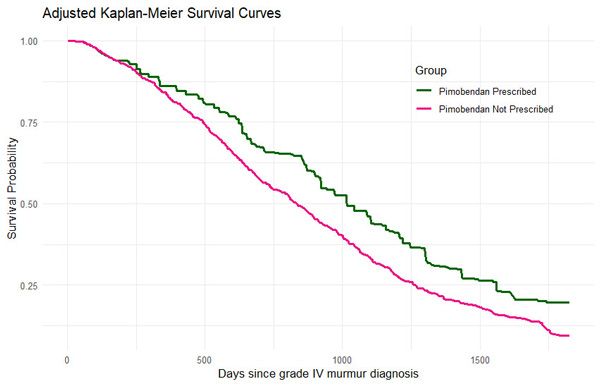Clinical value of pimobendan in canine heart disease management – NEW DATA
Target trial emulation applies design principles from randomised controlled trials (RCTs) to the analysis of observational data, with the aim of replicating RCT findings in everyday clinical settings. One of the most influential veterinary RCTs, The Evaluation of Pimobendan In Cardiomegaly (EPIC) trial, reported that pimobendan delays the onset of congestive heart failure (CHF) and extends survival in dogs with preclinical degenerative mitral valve disease (DMVD). Dr Camilla Pegram BVetMed MRes PhD MRCVS, Lecturer in Veterinary Epidemiology, Royal Veterinary College, University of London, discusses recent research that applied target trial emulation to explore whether the benefits reported in the EPIC trial can also be observed in primary-care practice
In the new VetCompass research, the point of intervention was defined as the diagnosis of a grade IV/VI heart murmur. The featured study compared dogs prescribed pimobendan within six months of a grade IV murmur to those not prescribed pimobendan within six months, analysing anonymised records from 928 dogs attending UK primary-care veterinary practices. The findings identified that the risk of CHF at five years was substantially lower in dogs prescribed pimobendan (34.1 per cent) than dogs not prescribed pimobendan (56.3 per cent). Dogs prescribed pimobendan had 311 fewer days of health lost to CHF within five years. Additionally, dogs prescribed pimobendan lived longer (adjusted mean survival time 1,051 days) than dogs not prescribed pimobendan (905 days). The findings demonstrate that target trial emulation within veterinary research can replicate findings from RCTs. Clinically, they suggest that preclinical grade IV murmur diagnosis may offer an appropriate intervention stage to begin pimobendan therapy in dogs with presumed DMVD.
Background
The EPIC trial was a multicentre, randomised, double-blinded, placebo-controlled trial that assessed the preclinical treatment of DMVD in dogs and remains one of the most influential investigations into canine cardiology (Boswood et al, 2016). The EPIC trial investigated the effect of pimobendan, a vasodilator and positive inotrope, on time to a primary endpoint of CHF, cardiac-related death, or euthanasia in dogs with stage B2 DMVD (Boswood et al, 2016). Based on the American College of Veterinary Internal Medicine (ACVIM) staging system, DMVD is classified into four categories (A to D), with stage B representing preclinical disease and C and D indicating clinical signs of CHF. Stage B is further subcategorised into stage B1 (no evidence of cardiac remodelling) and B2 (evidence of left atrial and ventricular enlargement) (Hezzell, 2018).
The EPIC trial demonstrated that pimobendan delayed CHF, cardiac-related death, or euthanasia by a median of 462 days and increased overall survival, with the median time to all-cause mortality 1,059 days in treated dogs versus 902 days in untreated dogs (Boswood et al, 2016). These findings reshaped clinical practice, positioning pimobendan as a cornerstone therapy in the preclinical management of DMVD.
DMVD is a common condition, affecting approximately one in 28 dogs in England, with breeds such as Cavalier King Charles Spaniels, King Charles Spaniels, Whippets, Poodles and Yorkshire Terriers particularly predisposed (Mattin et al, 2015). While echocardiography provides the gold-standard for DMVD staging, it is not always feasible in primary-care settings. A recent study reported that murmur intensity ≥ III/VI is associated with increased likelihood of stage B2 disease (Wilshaw et al). Murmurs are typically graded as I – VI, with grade I representing the least and grade VI the most intense murmurs (Rishniw, 2018). Murmur assessment is a somewhat subjective measure, but can be detected during a routine physical examination and therefore facilitates effective diagnosis and could play a role in identifying dogs that may benefit from preclinical treatment (Rishniw, 2018; Wilshaw et al).
The Veterinary Companion Animal Surveillance System (VetCompass) is a research programme that collects and analyses anonymised clinical data from veterinary practices. Started by the Royal Veterinary College (RVC) in the UK, VetCompass has expanded internationally, providing a comprehensive picture of disease management in everyday settings. The data collected for the DMVD study (discussed below) came directly from primary-care veterinary clinics, reflecting real-world scenarios. This provides a more accurate picture of disease management and outcomes compared to controlled or referral studies that might not capture everyday veterinary practice. VetCompass harnesses the power of large datasets and real-world evidence, enhancing understanding of animal health, which can ultimately result in the overall improved health and welfare of animals (RVC, 2023).

Figure 1: Directed acyclic graph (DAG) based on existing evidence and expert knowledge used to identify factors to control for when evaluating the effect of pimobendan prescription for degenerative mitral valve disease in dogs on congestive heart failure. The same causal structure was assumed to be sufficient for all-cause mortality as the outcome of interest.
While RCTs are still considered the gold standard for determining treatment effects, they aren’t always practical - or ethical - in a clinical setting. Target trial emulation provides a way forward. This novel approach lets researchers mimic the conditions of an RCT using existing data from routine veterinary records, which means we can draw conclusions on real-world treatment effects without having to rely solely on traditional trials (Pegram et al, 2023; Pegram et al, 2024a; Pegram et al, 2024b; Pegram et al, 2025).
The DMVD study is the fourth in a series of VetCompass papers using the “target trial emulation” approach. The first study evaluated whether antimicrobial or gastrointestinal nutraceutical treatment in acute, uncomplicated canine diarrhoea causes improved clinical outcomes (Pegram et al, 2023). The second study evaluated whether surgical or non-surgical management for cranial cruciate ligament rupture in dogs causes improved clinical outcomes (Pegram et al, 2024a). The third study compared the causal effects between neutering at 3 to < 7 months and neutering at ≥ 7 to ≤ 18 months on subsequent diagnosis with early-onset urinary incontinence in bitches (Pegram et al, 2024b). Together, these studies illustrate the potential of target trial emulation to answer clinically-relevant questions using real-world data.

Figure 2: Cumulative incidence (after bias adjustments), over a maximum five-year follow-up period, for congestive heart failure in dogs attending primary-care practices in the UK prescribed pimobendan and dogs not prescribed pimobendan within six months of first grade IV/VI heart murmur diagnosis.
VetCompass study summary
This VetCompass study set out to emulate aspects of the EPIC trial using real-world primary-care data. Specifically, the new study aimed to determine whether pimobendan prescription within six months of first detecting a grade IV heart murmur in dogs led to a delay in CHF or cardiac-related death and extended survival, compared with no pimobendan prescription. This approach aimed to replicate a randomised clinical trial. To guide our analysis, we created a causal diagram (also called a directed acyclic graph, or DAG) that laid out our understanding of the possible causal relationships at play. This helped us identify the key factors we needed to account for during the study. So, we collected data on the following factors: age, breed, insurance status, chronic comorbidities, diagnostic tests performed and veterinary group (as shown in Figure 1). By doing so, we aimed to build a comprehensive picture of how these variables might interact with each other and influence the outcome.
The emulated trial included a sample of 928 dogs with an adult bodyweight ≤ 15kg and > six years of age on January 1, 2016. Of these, 178 (19.2 per cent) dogs were prescribed pimobendan within six months of first grade IV murmur diagnosis and 750 (80.8 per cent) dogs were not prescribed pimobendan within six months of first grade IV murmur diagnosis. In the analysis, complex statistical methods balanced the two groups of dogs across other characteristics (as identified in Figure 1) namely age, breed, insurance status, chronic comorbidities, diagnostic tests performed and veterinary group. This effectively meant that the only difference between the two groups was that one group was prescribed pimobendan, while the other was not.

Figure 3: Survival curves (after bias adjustments), over a maximum five-year follow-up period, for all-cause mortality in dogs attending primary-care practices in the UK prescribed pimobendan and dogs not prescribed pimobendan within six months of first grade IV/VI heart murmur diagnosis.
Dogs prescribed pimobendan had a median age of 9.9 years – younger than the median age of dogs not prescribed pimobendan (10.6 years). After adjustments to balance differences, the key study findings included:
- risk of CHF at five years was 34.1 per cent in dogs prescribed pimobendan, compared to 56.3 per cent in dogs not prescribed pimobendan (Figure 2);
- survival at five years was 19.8 per cent in dogs prescribed pimobendan, compared to 9.6 per cent in dogs not prescribed pimobendan (Figure 3);
- dogs prescribed pimobendan had 311 fewer days of health lost to CHF within five years; and,
- adjusted mean survival time was 1,051 days in dogs prescribed pimobendan versus 905 days in dogs not prescribed pimobendan.
Put simply, pimobendan prescription within six months of a grade IV murmur diagnosis led to dogs staying healthier for longer – around 10 extra months free from CHF - and living, on average, about five months longer overall. The effect appeared stronger for delaying CHF onset than for prolonging survival, though both benefits were evident.
The study provides proof of concept that target trial emulation can reliably replicate results from an existing RCT in veterinary research, with similar treatment effects observed for pimobendan across both RCT and real-world settings. The consistency between these findings supports the greater use of target trial emulation within veterinary research, particularly when RCTs are not practical or ethical, or are too costly. The findings suggest preclinical grade IV murmur diagnosis may be an appropriate intervention stage for pimobendan prescription in dogs with presumed DMVD, which further studies might help to clarify. Pimobendan treatment based on a grade IV murmur diagnosis may benefit dogs where echocardiography-based staging is not feasible due to financial or other constraints or where access to advanced diagnostic imaging is limited.
The full study is available open access:
https://journals.plos.org/plosone/article?id=10.1371/journal.pone.0325695
with an accompanying research infographic:
https://www.rvc.ac.uk/Media/Default/VetCompass/250512_DMVD_Infographic.pdf
1. What proportion of dogs prescribed pimobendan within six months of a grade IV/VI murmur developed congestive heart failure (CHF) within five years?
- 19.8 per cent
- 34.1 per cent
- 56.3 per cent
- 80.8 per cent
2. True or false: Pimobendan was effective both in delaying the onset of CHF and in extending overall survival, with the stronger effect observed in delaying CHF.
- True
- False
3. By how many days did pimobendan treatment reduce the average number of days of health lost to CHF within five years?
- 105 days
- 200 days
- 311 days
- 450 days
4 Which of the following statements about DMVD in dogs is correct?
- Stage B2 represents preclinical disease with evidence of left atrial and ventricular enlargement.
- Stage C represents preclinical disease without cardiac remodelling.
- DMVD is rare and affects fewer than 1 in 100 dogs.
- Echocardiography is unnecessary for staging DMVD.
5. How do the survival times for dogs treated and untreated with pimobendan compare between the EPIC trial and the VetCompass trial emulation?
- Survival times were substantially longer in the EPIC trial for both treated and untreated groups compared with the trial emulation.
- Survival times were very similar between the EPIC trial and the VetCompass trial emulation.
- Survival times were much shorter in the EPIC trial for both treated and untreated groups compared with the trial emulation.
- Survival of treated dogs was substantially longer in the EPIC trial, but survival of untreated dogs was shorter, compared with the trial emulation.
ANSWERS: 1B; 2A; 3C; 4A; 5B.
1. How many Genera of PCV virus have been identified to date?
A. 3
B. 2
C. 4
D. 1
2. Mutations in the PCV virus are most commonly seen in which gene which encodes for the PCV2 protein coat?
A. Open Reading Frame 2 (ORF2) gene
B. Open Reading Frame 1 (ORF1 ) gene
C. Open Reading Frame 3 (ORF3) gene
D. E2 Ubiquitin Ligase
3. What percentage of PCV2 field strains are recombinant viruses?
A. 10%
B. 22%
C. 40%
D. 33%
4. Subclinical disease is the most common form of PCV2 infection. True or False?
A. True
B. False
5. Which genotype of PCV2 form the basis of the vaccines produced before 2021?
A. a
B. d
C. g
D. h
Answers: 1C; 2A; 3D; 4A; 5A.









